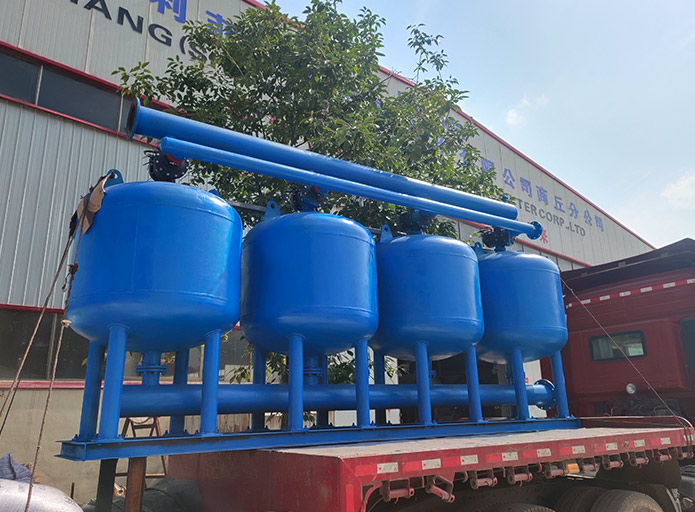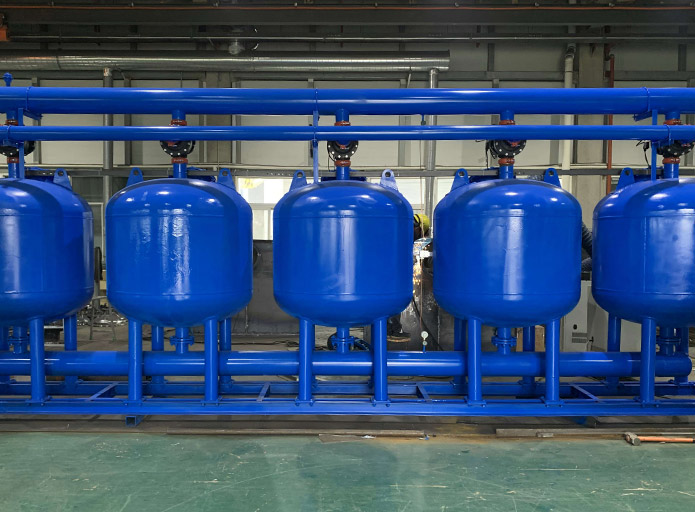1. Product Introduction
The shallow sand filter is a widely - utilized and cost - effective water treatment device that leverages the natural filtration properties of sand to purify fluids. This filter primarily consists of a carefully graded bed of sand, usually made from high - quality quartz sand or other silica - based materials, housed within a sturdy vessel. Its simplicity in design and operation, along with high reliability, makes it an ideal choice for various applications ranging from small - scale residential use to large - scale industrial and municipal water treatment.
Shallow sand filters are designed to remove suspended solids, sediment, and particulate matter from water sources. The graded sand particles provide an extensive surface area for trapping contaminants, ensuring efficient filtration. Unlike some complex filtration systems, shallow sand filters require minimal maintenance and can operate continuously for extended periods with proper care. They are also highly adaptable to different water quality conditions and flow rates, making them a versatile solution in the field of water purification.

2. Working Principle
The operation of a shallow sand filter is based on two key processes: filtration and backwashing. During the filtration process, contaminated water enters the top of the filter vessel and passes downward through the sand bed. As the water flows through the pores between the sand grains, suspended solids and particulate matter are physically trapped in the narrow spaces, a phenomenon known as straining.
In addition to straining, the surface of the sand grains also plays a role in adsorption. The rough and porous surface of the sand attracts smaller particles and colloids through van der Waals forces and electrostatic attraction, further enhancing the filtration efficiency. As the sand bed accumulates contaminants over time, the pressure drop across the filter increases. When this pressure drop reaches a pre - set threshold, it signals that the filter needs cleaning, and the backwashing process is initiated.
During backwashing, clean water is pumped upward through the sand bed at a high flow rate. This reverse flow causes the sand grains to expand and fluidize, breaking the bonds between the contaminants and the sand surface. The dislodged contaminants are then carried away by the backwash water and flushed out of the filter through a drain, restoring the filter's original filtration capacity. Once the backwashing is complete, the filter resumes its normal filtration operation.
3. Technical Parameters
3.1 Sand Grain Size
The grain size of the sand used in the filter is a critical parameter. Typically, the sand grains range from 0.5 to 1.2 millimeters in diameter. Smaller grain sizes (0.5 - 0.8 mm) offer higher filtration precision, ideal for removing fine particles, while larger grain sizes (0.8 - 1.2 mm) allow for higher flow rates and are suitable for handling water with coarser contaminants.
3.2 Filtration Rate
The filtration rate of a shallow sand filter usually ranges from 5 to 20 cubic meters per hour per square meter of filter surface area. This rate can be adjusted based on the specific application requirements, such as the quality of the raw water and the desired level of purification. Higher filtration rates may lead to a shorter filter lifespan between backwashing cycles, while lower rates can extend the time between cleanings but reduce the overall throughput.
3.3 Sand Bed Depth
The depth of the sand bed in a shallow sand filter generally varies from 0.6 to 1.2 meters. A deeper sand bed provides a greater dirt - holding capacity, enabling the filter to operate for longer periods without requiring backwashing. However, it also increases the pressure drop across the filter, which may necessitate more energy to drive the water through the system.
3.4 Backwash Flow Rate
The backwash flow rate is essential for effective cleaning of the filter. It typically ranges from 30 to 60 cubic meters per hour per square meter of filter surface area. An appropriate backwash flow rate ensures that the sand bed is adequately fluidized, allowing for the complete removal of trapped contaminants. If the flow rate is too low, the filter may not be fully cleaned, while an excessively high flow rate can cause sand loss and damage to the filter structure.

4. Working Components
4.1 Filter Vessel
The filter vessel serves as the enclosure for the sand bed and other components. It is usually constructed from materials like fiberglass - reinforced plastic (FRP), stainless steel, or concrete, depending on the application's requirements. The vessel has an inlet for the contaminated water, an outlet for the filtered water, and additional ports for the backwash process, ensuring proper water flow control.
4.2 Sand Bed
The sand bed is the core component of the filter, responsible for the actual filtration process. The sand is carefully graded and packed to ensure uniform distribution of water flow and maximum filtration efficiency. The quality and characteristics of the sand, such as its hardness, roundness, and chemical stability, significantly impact the filter's performance.
4.3 Under - Drain System
The under - drain system is located at the bottom of the filter vessel. Its main function is to collect the filtered water during normal operation and distribute the backwash water evenly during the cleaning process. The under - drain system is typically made of perforated pipes or plastic grids, designed to prevent sand from escaping while allowing water to pass freely.
4.4 Control Valves
Control valves are used to regulate the flow of water through the filter. They control the direction of water flow during filtration and backwashing operations. These valves can be manually operated or automated, with automated systems often using programmable logic controllers (PLCs) to manage the filtration and backwashing cycles based on pressure sensors and other monitoring devices.
5. Application Areas
5.1 Municipal Water Treatment
In municipal water treatment plants, shallow sand filters are commonly employed as a pre - treatment step. They effectively remove large - sized suspended solids, sediment, and turbidity from raw water sources, protecting downstream treatment processes such as disinfection and reverse osmosis. By reducing the load of contaminants, shallow sand filters enhance the overall efficiency and lifespan of the entire water treatment system.
5.2 Industrial Water Treatment
In various industrial sectors, including power generation, manufacturing, and chemical processing, shallow sand filters are used to filter process water, cooling water, and wastewater. They prevent the buildup of scale, corrosion, and fouling in pipes, heat exchangers, and other equipment, ensuring smooth operation and reducing maintenance costs. For example, in power plants, these filters help protect steam turbines by removing impurities from the cooling water.
5.3 Irrigation Systems
Shallow sand filters are widely applied in agricultural irrigation systems. They filter water from wells, rivers, or lakes, removing debris, silt, and other particles that could clog irrigation nozzles and pipes. By providing clean water for irrigation, these filters contribute to efficient water use and healthy crop growth.
5.4 Swimming Pools and Spas
In swimming pools and spas, shallow sand filters play a crucial role in maintaining water clarity and hygiene. They remove dirt, leaves, and other contaminants, reducing the reliance on chemical treatments and ensuring a clean and safe swimming environment for users.
In conclusion, the shallow sand filter is a reliable and efficient water treatment solution with a wide range of applications. Its straightforward working principle, well - defined technical parameters, and essential working components make it an indispensable part of many water purification systems.
{sval:sql sql='SELECT n_parameter FROM dede_addonarticle WHERE aid = ~aid~ ' } {/sval:sql}
{sval:sql sql='SELECT n_parameter FROM dede_addonarticle WHERE aid = ~aid~ ' } {/sval:sql}




















